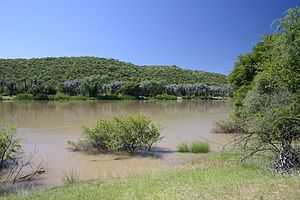Dorsland Trek

Dorsland Trek (English: Thirstland Trek) is the collective name of a series of explorations undertaken by Boer settlers from South Africa towards the end of the 19th century and in the first years of the 20th century, in search of political independence and better living conditions. The participants, trekboere (migrating farmers) from the Orange Free State and Transvaal, are called Dorsland trekkers.
Political background and previous treks
After escaping the autocratic rule of the Dutch East India Company in the late 18th century, semi-nomadic settlers at the Cape Colony came into conflict both with the indigenous Xhosa tribes in the east and the British who acquired the Cape as a result of the Napoleonic Wars. In 1836 they set off to what became known as the Great Trek, establishing the Orange Free State and Transvaal as independent Boer republics.[1]
There are two theories why the settlers would take off yet again to explore territory further north. One is that in the 1870s Britain again began the process of annexing these states,[2] the other claims that "[t]hey appeared compelled by a desire to trek." with no particular difficulty facing them at their current place.[1]
Routes of the trek
The first group of the Dorsland Trek started off on 27 May 1874 under the leadership of Gert Alberts.[3] A number of different groups of farmers, taking different routes, followed the first. They set off from the areas around Rustenburg,[1] Groot Marico,[4] and Pretoria,[2] the main aim were the Humpata highlands of south-western Angola. On their journey the settlers had to traverse the vast arid areas of the Kalahari through what today forms Namibia and Botswana. It was these hard conditions that gave the trek the name Dorsland Trek.[4]

The settlers entered Angola by crossing the Cunene River at Swartbooisdrift. The Portuguese colonial authorities encouraged the Boers to settle on the Huíla Plateau at Humpata where the bulk of them remained, while a number of families went further north, settling at different places on the Central Highlands. All of them formed an entirely closed community which refused integration and resented the Portuguese prohibition of the use of Afrikaans at schools, and their attempted to convert them to Catholicism. Also, their refusal of any kind of innovation - comparable to that of the Amish - caused many of them to empoverish, and even to end in outright misery. As a result, they turned southwards back into South-West Africa, starting after World War I.[2] some returned to where they came from.[1][5] The last of them left Angola in 1974, when the country became independent in the middle of a civil war.
A number of farmers settled in the Otavi - Tsumeb - Grootfontein triangle[2] and in the area around Gobabis. Some took a different route and crossed Kaokoland.[4] On their way southwards they discovered water at Sesriem and named it accordingly: Ses riem, six belts, was the depth of the canyon.[2]
Historical Impact
Not everywhere were the Boers well received. As early as in 1874 Herero chiefs Maharero, Kambazembi, and Christian Wilhelm Zeraua requested the Cape authorities to intervene with their settlement in Damaraland. As a result, a position of Special Commissioner for Damaraland was created.[6] In the area around Gobabis, Kaiǀkhauan Kaptein Andreas Lambert on behalf of all leaders of Damaraland threatened to harm them if they did not leave.[7]
Remains of the Dorsland Trek
In Kaokoland, several ruins of temporary settlements are still visible, including a dopper church (dopper = wooden pole) near Kaoko Otavi. Outside Swartbooisdrift the Dorsland Trekkers Monument has been erected to commemorate the journey. At Humpata there are several graves of the settlers, including that of their leader, Gert Alberts.[8]
See also
References
- ↑ 1.0 1.1 1.2 1.3 Joubert, Bruce. "An historical perspective on animal power use in South Africa". Animal Traction Network for Eastern and Southern Africa.
- ↑ 2.0 2.1 2.2 2.3 2.4 "The Dorsland Trekkers". tourbrief.com. Retrieved 25 June 2010.
- ↑ "The first group of Dorslandtrekkers (Thirstland trekkers), under leadership of Gert Alberts, leaves Pretoria". South African History Online. Retrieved 31 January 2014.
- ↑ 4.0 4.1 4.2 "The Dorsland Trek 4x4 Route". NamibWeb. Retrieved 25 June 2010.
- ↑ G. Clarence-Smith: The thirstland trekkers in Angola - Some reflections on a frontier society.
- ↑ Mashuna, Timotheus (2 March 2012). "Kambazembi Wa Kangombe: The Influential and Peace-Loving Herero Chief (1846 – 1903)". New Era.
- ↑ Shiremo, Shampapi (14 January 2011). "Captain Andreas Lambert: A brave warrior and a martyr of the Namibian anti-colonial resistance". New Era.
- ↑ "Dorsland Gedenkfees" [Thirstland commemoration] (in Afrikaans). Retrieved 25 June 2010.
External links
- Wilkinsons World Picture of the Dorsland Trekkers Monument